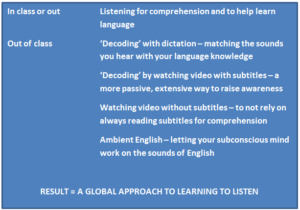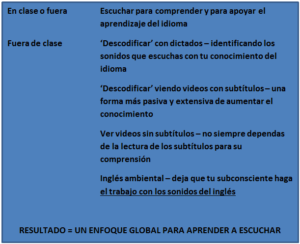Ways of Listening

This post is about the different ways we can improve our listening in English. We will look at three ways of listening and how awareness of them can help our development.
«Coursebook» listening
Coursebooks often use listening activities to present grammar points, vocabulary or functional phrases. The recordings are done by actors in a manner which is generally not very authentic. The result of this is great for productive skills, in that the student can learn the language they need through the listening, but it does comparatively little for the key receptive skill of listening, especially in a real-world context. It is sometimes said that in this sense coursebooks deal with ‘learning through listening’ instead of ‘learning to listen’.
In-class teaching methodology also encourages listening for key words and guessing meaning from words in context in order to understand the main idea or key points of the listening text. This technique tries to focus the student on the important content words, rather than aiming for a more complete understanding of the spoken words. This approach is understandable given short time-frames to learn and preparation for exams which require candidates to find specific information in a listening text, but can we do more in terms of ‘learning to listen’?
Decoding
It is true that a native speaker of English will predict or fill in content while listening to another person speaking without necessarily ‘hearing’ every word they say. However, at the same time they also ‘decode’. This means they match the sounds that they hear with their own active vocabulary and knowledge of grammatical structures. For a native speaker this process is automatic, but for a learner of English it requires effort, concentration and most crucially, practice. This practice involves a more detailed, technical approach than just listening for comprehension. This is not to say that the ‘coursebook’ style of listening is in any way wrong, it is very often necessary to listen for the ‘gist’ of what someone is saying even if in the real world we don’t usually have a question to help focus us on the relevant information, but it is extremely beneficial to develop a more complete, and more reliable, listening skill.
So, how can we do this? One answer is really quite an old fashioned one, and that is by doing dictations. The modern difference to this old-school activity is the options that the internet now allows us to practice on our own with a large variety of dedicated websites. Some examples are more authentic than others, often within the same website, so it’s worth looking for dictations that sound more like ‘real’ English.
The following are some examples from the internet (there are many others), offering dictations according to level. You could also find some audiovisual content, do your own dictation and compare to a transcript in websites like the last two examples below. These sites also offers dialogues as an alternative to a monologues as well as a large variety of accents.
http://www.fonetiks.org/dictations/
http://www.breakingnewsenglish.com/dictation.html
http://www.learnenglish.de/dictationpage.html
http://www.elllo.org/ great for listening to different accents. You can hide the transcript and do all or part of the video as a dictation.
https://www.englishlistening.com/ also very impressive for accents and different ways of speaking.
Another possibility to help establish the connection between heard sounds and language knowledge is watching video with subtitles. Most TV series and films now offer this option, but there are also shorter online possibilities with subtitles such as TED Talks (where it is very easy to find something to suit all tastes). If you are a learner of intermediate level or higher, you will have probably received advice to watch TV and other audiovisual without subtitles. This is still good advice because you are practicing a different kind of listening (perhaps more related to the coursebook style mentioned above). Watching with subtitles has a different purpose, which is to train yourself in the sounds of English compared to how they sound and your own language knowledge. The most common criticism of this kind of exercise is that the learner relies too much on reading and forgets to listen. I believe that is a danger and for that reason the learner must understand the reason for doing this activity in order to maintain concentration on listening. Additionally, and if the learner’s level permits, they should also alternate with viewing without subtitles to maintain a balanced approach.
Ambient English
In the decoding English section we talked about intensive active practice using dictation and more extensive, passive practice in viewing video with subtitles. In this part our recommendation is to become even more passive! When you are cooking, or exercising, or even travelling you can have English media (podcasts or video, when possible) playing. Your can pay attention or not to the sounds you hear. The point is that even when you are not paying attention your subconscious mind is at work; you are becoming more accustomed to the sounds of English and you are allowing the language to become a part of the ‘background’ of your life. This is not to say that you can just put on a podcast and the learning will take care of itself, but passive listening can complement your learning to listen in useful ways. As you listen, your brain will begin to recognise patterns and repetitions in what you hear and prepare the way for active learning. Also, the more you practice intensive listening, with dictations for examples, the more meaning you will extract from passive listening so the benefit becomes a virtuous circle!
To sum up
To become better listeners we have to be aware of different ways of listening to define an effective strategy. A way to represent this strategy might be the following:
Formas de Escuchar
En este artículo se analizan distintas formas de aprender inglés a través de la escucha. Analizaremos 3 formas de escucha y cómo el conocerlas e identificarlas puede ayudarte a mejorar.
- Audiciones de libro de texto: los libros de texto con frecuencia utilizan actividades de audición para presentar puntos de gramática, vocabulario o frases funcionales. Las grabaciones están hechas por actores de una forma poco realista. Los resultados que se obtienen con estas audiciones son muy buenos para habilidades productivas en la que el estudiante puede aprender el vocabulario que necesita a través de la escucha, pero comparativamente aportan muy poco a la capacidad de entender, especialmente en el contexto del mundo real. En este sentido se suele decir que los libros de texto se basan en “aprendizaje a través de la escucha” en vez de “aprender a escuchar”.
La metodología de enseñanza en clase también fomenta la escucha de las palabras claves y la adivinación de significados de palabras por el contexto con el fin de entender la idea principal o los puntos principales del texto que se está escuchando. Esta técnica intenta enfocar al alumno en las palabras que transmiten el significado en lugar de pretender que comprenda la globalidad de las palabras pronunciadas. Esto puede entenderse en contextos en los que el aprendizaje se ha de producir en cortos periodos de tiempo y en preparaciones de exámenes en los que el alumno necesita encontrar información específica en una audición pero ¿podemos hacer más para “aprender a escuchar”?
- Descodificación: es cierto que un hablante de inglés nativo predecirá o completará contenido cuando escucha a otra persona sin necesidad de “escuchar” cada palabra que pronuncia. Sin embargo, ellos también “descodifican”. Lo que hacen es combinar los sonidos que escuchan con su vocabulario activo y el conocimiento de estructuras gramaticales. Para un hablante nativo este proceso es automático, pero para un estudiante de inglés requiere esfuerzo, concentración y lo más importante, práctica. Esta práctica implica un enfoque más técnico y detallado que no sea simplemente el de escuchar para entender. Esto no quiere decir que el estilo de audiciones de los libros de texto sea incorrecto, con frecuencia es necesario entender los puntos claves de lo que alguien está diciendo incluso aunque, en general, en el mundo real no tenemos una pregunta que nos ayude a enfocarnos en la información relevante, pero es extremadamente beneficioso desarrollar habilidades de escucha más completas y fiables.
Pero, ¿cómo lo conseguimos? Una respuesta bastante anticuada es haciendo dictados. Una alternativa moderna a esta actividad de la vieja de escuela son las opciones que nos presenta internet para practicar por nuestra cuenta con una gran variedad de páginas web dedicadas a ello. Algunos ejemplos son más auténticos que otros, incluso dentro de la misma página web, por lo que merece la pena seleccionar aquellos que suenen más a un inglés “real”.
Los siguientes enlaces son ejemplos de internet (hay muchos otros), que ofrecen dictados de acuerdo al nivel. Se pueden encontrar también contenidos audiovisuales, puedes hacer tus propios dictados y comparar con una transcripción en páginas web como los dos últimos ejemplos del listado. Estos sitios ofrecen también diálogos como alternativa a los monólogos así como una gran variedad de acentos.
http://www.fonetiks.org/dictations/
http://www.breakingnewsenglish.com/dictation.html
http://www.learnenglish.de/dictationpage.html
http://www.elllo.org/ genial para escuchar diferentes acentos. Puedes ocultar la transcripción y hacer todo o parte del video como un dictado.
https://www.englishlistening.com/ también muy importante por los acentos y diferentes formas de hablar.
Otra posibilidad que te ayudará a establecer una conexión entre los sonidos escuchados y tus conocimientos del idioma es ver videos con subtítulos. Muchas series de televisión y películas ofrecen esta opción en la actualidad, pero también existen vídeos más cortos como las TED Talks (donde encontrarás algo para todos los gustos). Si eres un estudiante de nivel intermedio o superior, probablemente te habrán aconsejado ver la televisión sin subtítulos. No deseches este consejo porque de esta manera estás practicando un tipo distinto de escucha (tal vez más relacionado con el estilo de los libros de texto comentado al principio). Pero ver vídeos con subtítulos tiene un propósito diferente, el objetivo es entrenarte en el reconocimiento de los sonidos del inglés e identificar estos sonidos del inglés con el conocimiento del lenguaje que tienes adquirido. La crítica más común a este tipo de ejercicio es que el estudiante se centra demasiado en la lectura y se olvida de escuchar. Esto supone un riesgo y por ello el estudiante debe ser consciente y comprender la razón por la que se hace esta actividad para mantener la concentración en la escucha. Además, y si el nivel del estudiante lo permite, se debería alternar con el visionado de programas sin subtítulos para mantener un equilibrio en el aprendizaje.
- Inglés ambiental: en la sección de la descodificación del inglés hablamos de una práctica activa intensiva como es el dictado y otra más pasiva y extensiva como es ver vídeos con subtítulos. En esta sección nuestra recomendación es ¡ser incluso más pasivo! Cuando estás cocinando, haciendo ejercicio, o incluso viajando puedes reproducir vídeos o podcast en inglés. No es tan relevante si prestas atención o no a los sonidos que oyes. La cuestión es que, incluso cuando no prestas atención, tu mente subconsciente está trabajando; te estás acostumbrando al sonido del inglés y estás permitiendo al idioma formar parte de la banda sonora de tu vida. No quiere decir que por poner un podcast el aprendizaje llegue por sí solo, pero la escucha pasiva sin duda complementará de manera útil tu aprendizaje. Mientras escuchas tu cerebro comenzará a reconocer patrones y repeticiones en lo que oyes y de esta manera se prepara para un aprendizaje activo. Además, cuanto más practiques escuchas intensivas con dictados, más significado extraerás de la escucha pasiva multiplicando el beneficio de manera exponencial.
En resumen:
Para llegar a ser mejores oyentes tenemos que ser conscientes de las diferentes formas de escucha que existen y así poder definir una estrategia efectiva. Aquí tienes una representación de esta estrategia:








